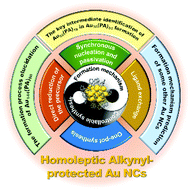Controllable synthesis and formation mechanism study of homoleptic alkynyl-protected Au nanoclusters: recent advances, grand challenges, and great opportunities
Abstract
In the past decade, atomically precise coinage metal nanoclusters have been a subject of major interest in nanoscience and nanotechnology because of their determined compositions and well-defined molecular structures, which are beneficial for establishing structure–property relationships. Recently ligand engineering has been extended to alkynyl molecules. Homoleptic alkynyl-protected Au nanoclusters (Au NCs) have emerged as a hotspot of research interest, mainly due to their unique optical properties, molecular configuration, and catalytic functionalities, and more importantly, they are used as a counterpart object for fundamental study to compare with the well-established thiolate Au NCs. In this review, we first summarize the recently reported various controllable synthetic strategies for atomically precise homoleptic-alkynyl-protected Au NCs, with particular emphasis on the ligand exchange method, direct reduction of the precursor, one-pot synthesis, and the synchronous nucleation and passivation strategy. After that, we switch our focus to the formation mechanism and structure evolution process of homoleptic alkynyl-protected Au NCs, where Au144(PA)60 and Au36(PA)24 (PA = phenylacetylide) are given as examples, along with the prediction of the possible formation mechanism of some other cluster molecules. In the end of this review, the outlook and perspective of this rapidly developing field including grand challenges and great opportunities are discussed. This review can stimulate more research efforts towards developing new synthetic strategies to enrich the limited examples and unravel the formation/growth mechanism of homoleptic alkynyl-protected Au NCs.

- This article is part of the themed collection: Recent Review Articles


 Please wait while we load your content...
Please wait while we load your content...